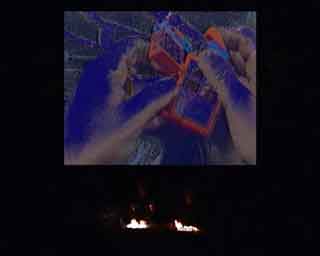 |
Living Cinema
|
|
Pierre Hébert/Bob Ostertag
|
| Living Cinema is the creation of Quebecois film maker Pierre Hébert and San Francisco composer Bob Ostertag. The project is innovative in many ways, bringing the creation of cinema out of the movie and recording studios and on to the stage. Ostertag has created innovative software which allows the two artists to actually perform an animated movie with soundtrack, live on stage. For decades, Hébert was considered one of the masters of the unusual craft of creating animated films by engraving directly on film. Living Cinema allows him to apply the craftsmanship acquired through years of engraving on film to whatever materials he wishes to use. Ostertag brings his years of experience with live manipulation of sampled sound to the project, using a variety of objects and techniques to create a soundtrack that is synchronized with the image as both are being created. The flexible, open-ended character of Living Cinema gives the artists the ability to respond immediately to political and cultural events in a way that conventional cinema never could. The work is thus profoundly influenced by world events. The performance is innovative enough to be difficult to describe to those who have not seen it, yet transparent enough to be easily grasped by those in attendance. Children have typically been among its most enthusiastic fans. |
 |
Tzadik DVD Edition #3002
Pierre Hébert/Bob Ostertag |
|
click on the images to open hi-rez photos suitable for press and publicity
|
||||
| << live |
Pierre and Bob >>
|
|||
| << stage | ||||
| The images in the second row are stills from the Between Science and Garbage DVD. They are 320 x 240 pixels. Since the performance is created at that resolution, there are no higher-rez versions of these images. While this is typically considered lower than production-spec, they have been used very effectively in newspapers, magazines, and concert programs around the world. | ||||
|
before >>
|
after >>
|
|||
| << black and white | ||||
| Between Science and Garbage is Living Cinema’s first production. Hébert creates images by drawing marker on paper, chalk on chalkboard, blowing dust on mirrors, and manipulating piles of garbage. Lots and lots of garbage. The garbage is used as both the subject of the animation and the source of the sound. Ostertag records the sound of garbage food, and manipulates it by drawing shapes on a digital drawing tablet.
Although technologically intensive, Living Cinema does not celebrate technology but questions it, and its relation to the bodies of performers and the world around us, and, of course, garbage. Today's cutting edge technology is of course tomorrow's garbage. This paradox is not banished to the shadows as an unspoken embarrassment, but is rather the starting point of the entire project. Ostertag and Hébert sit on stage and try to sense out of science and garbage -- a more explicit rendition of the situation we all live in every day. |
| Endangered Species, Living Cinema’s second work, features Ostertag using mechanical toy animals in a tuned and amplified boxing ring, where their images are captured by Hébert and become the basis for live animation |
| Portrait of Buddha is a more contemplative work in which vocal sounds and images from the concert location recorded the day of each show form the basis of an extended meditation. Hébert’s painting on glass in this work is suggestive of Japanese calligraphy. |
| Hunting Crows is currently in development. More theatrical in scope than the other works, Hunting Crows is an "interactive" work that uses stage "sets" that are drawn and projected during the performance. Beginning from an instructional recording for farmers concerning how to hunt crows, the piece investigates the violence of our times. , Hunting Crows is a sort of interactive theater work with "sets" that are drawn during the performance. usesa more contemplative work in which vocal sounds and images from the concert location recorded the day of each show form the basis of an extended meditation. Hébert’s painting on glass in this work is suggestive of Japanese calligraphy. |
|
Mouvement: Revue Indisciplinaire des Arts Vivants
No. 20, Janvier-Février 2003 "Le Corps Animé" |
|
|
Schnitt: Das Film Magazin
# 32 "Die Gemalte Projektion" |
|
|
New York Times
January 14, 2003 "Creating Layered Sounds to Match Layered Animations: Junk food and trash were the makings of "Between Science and Garbage" by Bob Ostertag, an electronic composer, and Pierre Hébert, an animator, on Thursday night. The music started with Mr. Ostertag popping the top of a Coke can; he handed the can to Mr. Hébert, who put its image on screen, to be combined with images of a swinging watch, an apple and a computer motherboard that looked like a city seen from the air. There were also drawings that Mr. Hébert made on the spot of a man falling, reaching for the apple or diving into a garbage can. |
|
|
Aichi Art Center
Nagoya, Japan "Living Cinema" |
|
|
Toronto Globe and Mail
October 31, 2001 "Mining Gold from a Wasted World" |
|
| In addition to the photos listed above, the following downloadable files will be useful to promoters organizing Living Cinema performances or film screenings. Click on the text to download. | ||